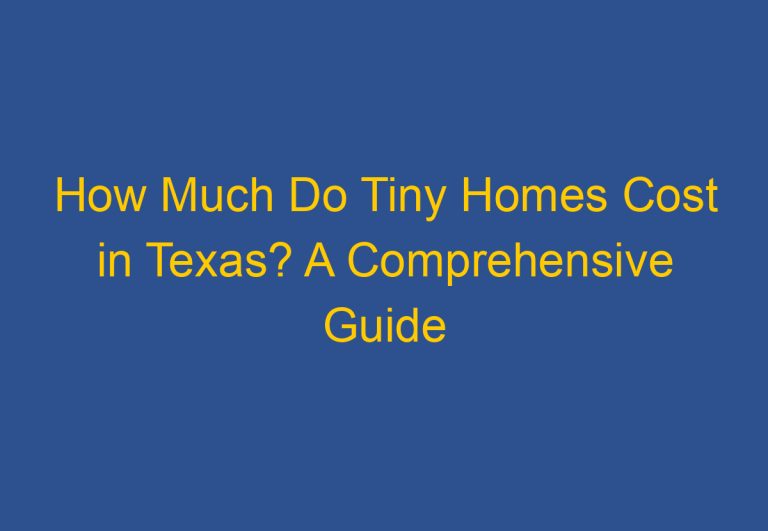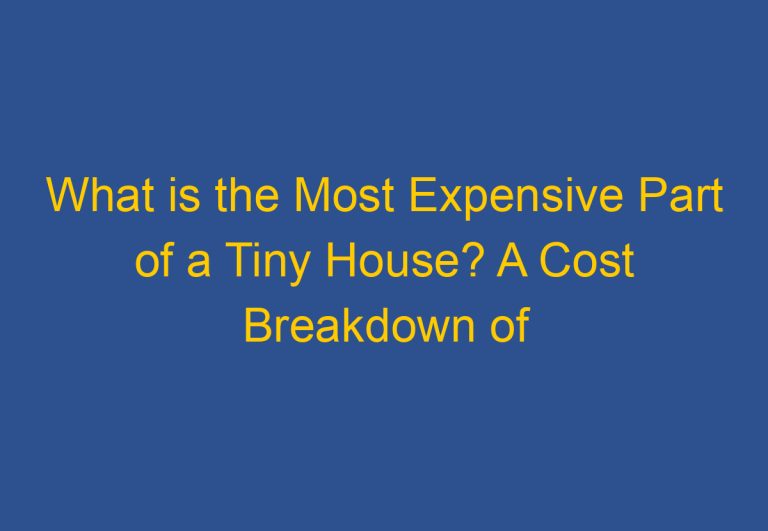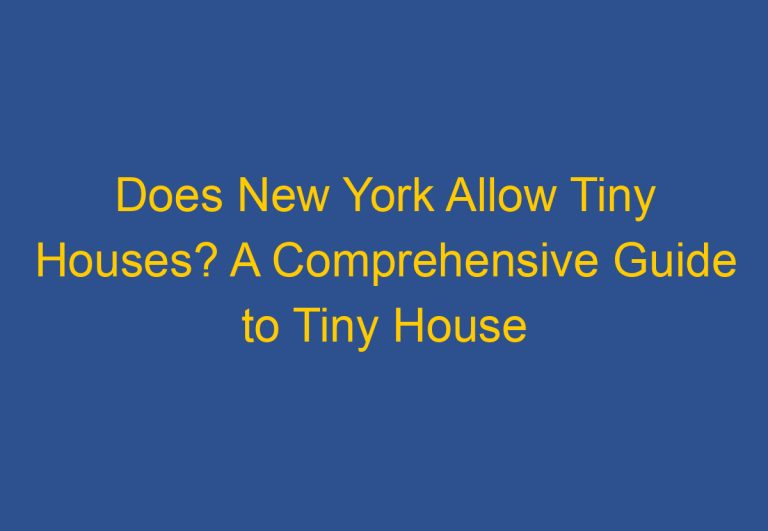Can You Really Live in a Tiny Home? The Truth About Downsizing Your Living Space
Living in a tiny home has become an increasingly popular trend in recent years. With the average American home size being around 2,600 square feet, the idea of living in a space that is only a fraction of that size may seem daunting to some. However, for others, it is a way to simplify their lives, reduce their environmental impact, and save money.
While the idea of living in a tiny home may seem appealing, many people wonder if it is actually feasible. Can you really live in a space that is only a few hundred square feet? The answer is yes, but it requires careful planning and consideration. Living in a tiny home means downsizing your possessions, being mindful of your energy usage, and making the most of every inch of space. It also requires a certain level of adaptability and creativity to make the space work for your individual needs and lifestyle.
The Essentials of Tiny Home Living
Living in a tiny home can be a great way to downsize, simplify, and live a minimalist lifestyle. However, there are some essential considerations to keep in mind when designing, building, and living in a tiny home. In this section, we will explore some of the most important factors to consider when embarking on the tiny home lifestyle.
Understanding Zoning and Building Codes
Zoning laws and building codes can vary greatly depending on the location of your tiny home. It is important to research and understand the regulations in your area before beginning the building process. Some areas may require a permit for a tiny home, while others may not allow them at all. It is also important to ensure that your tiny home meets all safety and building code requirements to ensure a safe and comfortable living space.
Selecting the Right Foundation
Choosing the right foundation for your tiny home is crucial to its longevity and stability. Some popular options include a trailer, a concrete slab, or a raised foundation. Each option has its own benefits and drawbacks, so it is important to consider factors such as mobility, cost, and climate when selecting the right foundation for your tiny home.
Designing for Small Spaces
Designing a tiny home requires careful consideration of every inch of space. It is important to create a functional and efficient floor plan that maximizes storage and living space. Some popular design features include multi-functional furniture, built-in storage, and creative use of vertical space. It is also important to consider the needs of all occupants, including children and pets, when designing a tiny home.
Lifestyle Considerations
Living in a tiny home requires a significant lifestyle change. It is important to consider factors such as storage, downsizing, and simplifying when transitioning to tiny home living. It can also be helpful to adopt a minimalist mindset and focus on the essentials to create a comfortable and functional living space. It is important to keep in mind that tiny home living is not for everyone, and it is important to carefully consider all lifestyle factors before making the transition.
In conclusion, living in a tiny home can be a rewarding and fulfilling lifestyle choice. However, it is important to carefully consider all essential factors, such as zoning and building codes, foundation selection, small space design, and lifestyle considerations, before embarking on the tiny home journey. With careful planning and consideration, tiny home living can be a comfortable and sustainable lifestyle choice for many individuals and families.
Practicalities of Tiny House Inhabitance
Living in a tiny house requires some adjustments and a different approach to daily life. In this section, we’ll explore some practical aspects of tiny house living, such as maximizing storage and functionality, creating comfort in compact quarters, navigating financial and legal aspects, and embracing community and sustainability.
Maximizing Storage and Functionality
One of the biggest challenges of living in a tiny house is finding enough storage space. However, with some creativity and smart hacks, it’s possible to make the most of every inch of your tiny home. For example, you can use vertical space by installing shelves, hooks, and baskets on walls and ceilings. You can also use multi-functional furniture, such as a bed with built-in storage or a table that can be folded away when not in use.
Creating Comfort in Compact Quarters
Living in a tiny house doesn’t mean sacrificing comfort. With some thoughtful design choices, you can create a cozy and inviting space that feels like home. For example, you can use warm colors, soft textures, and natural materials to make your tiny house feel more welcoming. You can also invest in comfortable furniture, such as a plush sofa or a cozy armchair.
Navigating Financial and Legal Aspects
Before embarking on a tiny house lifestyle, it’s important to consider the financial and legal aspects of tiny house living. For example, you’ll need to research zoning laws and building codes in your area to make sure you can legally live in a tiny house. You’ll also need to consider the cost of building or buying a tiny house, as well as ongoing expenses such as utilities, insurance, and maintenance.
Embracing Community and Sustainability
One of the benefits of tiny house living is the opportunity to embrace community and sustainability. Many tiny house owners are passionate about reducing their environmental footprint and living a simpler, more intentional lifestyle. You can connect with other tiny house enthusiasts through online forums and local meetups. You can also explore eco-friendly options for water sources, composting toilets, and appliances.
In summary, living in a tiny house requires some adjustments and a different approach to daily life. However, with some creativity and smart hacks, it’s possible to make the most of every inch of your tiny home. By embracing community and sustainability, you can also enjoy a more fulfilling and rewarding lifestyle.
Frequently Asked Questions
What are the long-term costs of living in a tiny home compared to a traditional house?
The long-term costs of living in a tiny home are generally lower than traditional houses. However, the cost of building a tiny home can vary depending on the size, customization, quality, and features. According to the search results, the average cost of a tiny home ranges from $25,000-$50,000 for a DIY project and $65,000-$100,000 for a custom-built home by a company. It is important to consider the upfront costs of building or buying a tiny home and the ongoing maintenance costs.
How do tiny homes impact the quality of life and relationships for their inhabitants?
Living in a tiny home can impact the quality of life and relationships for their inhabitants. On the one hand, tiny homes can promote a minimalist lifestyle, which can lead to a simpler and more fulfilling life. On the other hand, the limited space can cause stress and tension in relationships, particularly if the inhabitants have different lifestyles or preferences. It is important to consider the impact of tiny homes on the quality of life and relationships before deciding to move into one.
What are the legal implications of residing in a tiny home permanently?
Navigating land use laws is essential for legally setting up a tiny home. Understanding utility and off-grid options is key for sustainable tiny living. Securing specialized insurance is necessary for risk management in tiny homes. The maze of building codes, zoning laws, and property regulations can feel like walking through a minefield. It is important to research and understand the legal implications of residing in a tiny home permanently before making the move.
What is the average lifespan of a tiny home and how does it compare to conventional housing?
The average lifespan of a tiny home can vary depending on the quality of construction, maintenance, and usage. However, with proper care and maintenance, a tiny home can last as long as a conventional house. It is important to consider the materials used in building a tiny home and the quality of construction to ensure its longevity.
How do residents of tiny homes deal with the limited space on a daily basis?
Residents of tiny homes need to be creative and resourceful in dealing with the limited space on a daily basis. They need to maximize the use of vertical space, use multi-functional furniture, and adopt a minimalist lifestyle. It is important to consider the practicalities of living in a tiny home and whether it is suitable for one’s lifestyle and preferences.
What are the most common reasons people choose to move into, or out of, tiny homes?
The most common reasons people choose to move into tiny homes are affordability, sustainability, and freedom from material possessions. However, people may also move out of tiny homes due to the limited space, lack of privacy, and difficulties in finding suitable land for parking. It is important to consider the pros and cons of living in a tiny home and whether it is suitable for one’s lifestyle and preferences.










